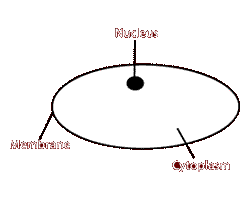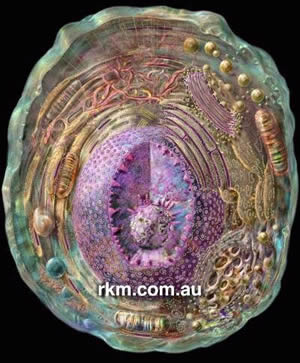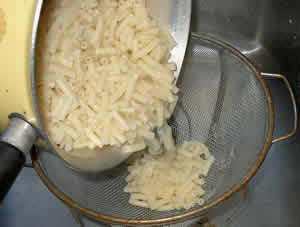Week 10 - Cells
| Site: | MoodleHUB.ca 🍁 |
| Course: | Science 8 LearnNet |
| Book: | Week 10 - Cells |
| Printed by: | Guest user |
| Date: | Monday, 17 November 2025, 5:42 PM |
Description
Week 10 - Cells
1. Plant and Animal Cells
Lesson 5
Science in Action 8
Pages 103-108, 111-114
ScienceFocus 8
Pages 115, 121-127
Lesson 5: Plant and Animal Cells
http://learn.argyll.epsb.ca/Science/Sci8/AOC/Background Information
Figure 1. Illustration of the major regions of a living cell.
When Robert Hooke observed cork in 1665, he was looking at dead cells. All he could see was the cell wall of a plant cell. Living cells are dynamic and have several things in common.
All cells have a cell membrane . This is the outer boundary of the cell and controls what enters and leaves the cell.
All cells have a gel-like cytoplasm . The cytoplasm contains the chemicals and water that the cell needs to survive. It also contains the tiny structures that carry out the life process for the cell.
All cells, with the possible exception of red blood cells in humans, contain hereditary material. The hereditary material determines the structure and the function of the cell and is found in the nucleus of plant and animal cells. The Cell Factory
Each cell in your body has a specific job to do. The activities in your cells might be compared to a factory that operates around the clock making dozens of different products.
The factory has a definite structure. A cell is similar. It functions inside a structure called the cell membrane.
Products enter and leave the factory through doors. Similarly, substances move into a cell and products and wastes move out.
Machinery inside the factory make products and generate wastes that must be removed. The cell contains tiny structures that make products and generate wastes that must be removed.
The factory is controlled from a central office. The nucleus of a cell is described as the control center of the cell.
Animal Cells
Figure 2 represents the main parts of an animal cell.
Figure 1. Illustration of the major regions of a living cell.

When Robert Hooke observed cork in 1665, he was looking at dead cells. All he could see was the cell wall of a plant cell. Living cells are dynamic and have several things in common.
All cells have a cell membrane . This is the outer boundary of the cell and controls what enters and leaves the cell.
All cells have a gel-like cytoplasm . The cytoplasm contains the chemicals and water that the cell needs to survive. It also contains the tiny structures that carry out the life process for the cell.
All cells, with the possible exception of red blood cells in humans, contain hereditary material. The hereditary material determines the structure and the function of the cell and is found in the nucleus of plant and animal cells. The Cell Factory
Each cell in your body has a specific job to do. The activities in your cells might be compared to a factory that operates around the clock making dozens of different products.
The factory has a definite structure. A cell is similar. It functions inside a structure called the cell membrane.
Products enter and leave the factory through doors. Similarly, substances move into a cell and products and wastes move out.
Machinery inside the factory make products and generate wastes that must be removed. The cell contains tiny structures that make products and generate wastes that must be removed.
The factory is controlled from a central office. The nucleus of a cell is described as the control center of the cell.
Animal Cells
Figure 2 represents the main parts of an animal cell.

- Animal cells are surrounded by a cell membrane. You will learn more about the cell membrane in another lesson.
- Most animal cells contain a nucleus. The nucleus is the largest structure in the cytoplasm. The nucleus directs all the activities of the cell. Chromosomes are found inside the nucleus. The chromosomes contain the hereditary material.
- The cytoplasm of an animal cell contains structures called organelles. The nucleus, for example, is an organelle. Each organelle has a specific job or jobs. Some organelles break down food molecules. Others transform the chemical energy in food into another form of chemical energy that the cell can use. Some organelles move wastes to be expelled from the cell. The vacuoles are storage organelles in cells. They may store water, waste products, foods, and other cellular materials.
Plant Cells
Figure 3 represents the parts of a plant cell.

A plant cell has many of the same parts as an animal cell. There are two main differences between plant and animal cells.
- Plant cells have a cell wall. The cell wall is a rigid structure that supports and protects the plant cell. It is composed of fibres made of cellulose. You are familiar with these fibres if you ever got the stringy stuff in celery stuck between your teeth.
- Plants cells have the ability to manufacture their own food through the process of photosynthesis. Photosynthesis occurs in chloroplasts. Chloroplasts are organelles that contain the pigment chlorophyll. Chlorophyll is the pigment that traps and transforms light energy into chemical energy and stored in sugar molecules.
|
Experiment Time - Cells

Locate the web site named An Introduction to Microscopy.
http://www.microscopy-uk.org.uk/index.html?http://www.microscopy-uk.org.uk/ponddip/index.html Select two organisms from the jar and read about more about them in the virtual field guide. Check Your Understanding Do the Check and Reflect questions found on page 109.
Do the Check and Reflect questions found on page 114.
|
||||||||||||||||||||||||||||||||||||||
|
© 2002 Alberta Online Consortium
|
2. Cell Transport
Lesson 6
Science in Action 8
Pages 115-119
ScienceFocus 8
Pages 128-131, 134-137
Lesson 6: Cell Transport
Diffusion
Definition of diffusion : Diffusion is the movement of molecules from an area of high concentration to an area of low concentration.
Molecules in a solid, liquid, and gas are in constant motion. When molecules move from an area where there are more of them, into areas where there are few of them, it is called diffusion . In the food colouring activity that follows, there are more molecules of food colouring in a drop of food colouring than in the water you add the food colouring to. You will investigate to see if the food colouring particles move from areas of high concentration to areas of low concentration.
Cell Transport
Most of you have made macaroni and cheese or some type of boiled pasta for lunch. You cook the pasta in boiling water. When the pasta is cooked, you pour it into a strainer in your sink. The water goes through the strainer but the pasta (at least most of it) stays in the strainer or a sieve. Particles smaller than the openings in the grid pass through. In this example, the water particles are small enough to pass through the openings. Particles that are larger than the openings in the grid stay in the strainer. Obviously, the macaroni is too big to pass through the openings.

A cell membrane performs in a similar way for the cell as the strainer does for the pasta. It allows some things to enter or leave the cell while keeping other things outside or inside the cell. When membranes function this way, they are called selectively permeable. The strainer (sieve) is selectively permeable based on the size of the openings. The pot, on the other hand, does not let anything pass through its sides or bottom. The pot is impermeable because it does not allow anything to pass through it.
Osmosis
Water makes up a large part of a living cell. The diffusion of water through the cell membrane is called osmosis . Water moves from an area where there is more water to an area where there is less water. In a later activity you will see how that works in the carrot cells.
Definition of osmosis : Osmosis is the diffusion of water across a cell membrane from an area where there are more water molecules to an area where there are fewer water molecules.
3. Cellular Organization
Lesson 7
Science in Action 8
Pages 120-125
ScienceFocus 8
Pages 138-145
Lesson 7: Cellular Organization
Background Information
Living things are organized in special ways. Some living things, such as the paramecium are made up of only one cell (unicellular) . That one cell carries out all of the activities necessary for life. The unicellular organism responds to the environment, reproduces, and uses energy. You are likely more familiar with living things that are made up of many cells (multicellular) . An earthworm is an example of a multicellular organism. The cells of an earthworm are organized into groups. The cells of each group do special jobs. For example, cells that line the small intestine absorb nutrients that have been digested in other section of the worm's gut.
 Groups of cells, such as those in the intestine, are called tissues . A tissue is a group of cells that work together to carry out a special job. Bone, muscles, blood, and nerves are examples of tissues found in animals. Bark, the outer surface of leaves, and water conducting vessels are examples of tissues found in some types of plants. Like cells, tissues can be organized into groups. An organ is a group of tissues that work together to do a job. For example, in the pharynx is an organ found in an earthworm. The job of the pharynx is to suck food into the earthworm's gut. In earthworms, the pharynx, esophagus, crop, and intestine are organs that are involved with the digestion of food.
Groups of cells, such as those in the intestine, are called tissues . A tissue is a group of cells that work together to carry out a special job. Bone, muscles, blood, and nerves are examples of tissues found in animals. Bark, the outer surface of leaves, and water conducting vessels are examples of tissues found in some types of plants. Like cells, tissues can be organized into groups. An organ is a group of tissues that work together to do a job. For example, in the pharynx is an organ found in an earthworm. The job of the pharynx is to suck food into the earthworm's gut. In earthworms, the pharynx, esophagus, crop, and intestine are organs that are involved with the digestion of food.
 A group of organs that work together to do a certain job form an organ system . In earthworms, the organs of the digestive system work together to process the food that the worm eats. The organs of the circulatory system are responsible for the movement of blood and the transportation of nutrients of waste to and from every cell. In multicellular organisms, all the organ systems working together make up an organism. An organism is a living thing. Earthworms are organisms with several organ systems. They have digestive system and a circulatory system, to name only two systems. Note: For more information on earthworms or if you are interested in getting involved with the National Earthworm Survey, go to the Worm Watch website ( http://www.wormwatch.ca )
A group of organs that work together to do a certain job form an organ system . In earthworms, the organs of the digestive system work together to process the food that the worm eats. The organs of the circulatory system are responsible for the movement of blood and the transportation of nutrients of waste to and from every cell. In multicellular organisms, all the organ systems working together make up an organism. An organism is a living thing. Earthworms are organisms with several organ systems. They have digestive system and a circulatory system, to name only two systems. Note: For more information on earthworms or if you are interested in getting involved with the National Earthworm Survey, go to the Worm Watch website ( http://www.wormwatch.ca )
 Exercise 2.3: Cellular Organization
Exercise 2.3: Cellular Organization


|
Check Your Understanding Do the Check and Reflect questions found on page 124.
Do the Assess your Learning questions found on page 125.
|
© 2002 Alberta Online Consortium
4. Introduction to Human Body Systems
Lesson 8: Introduction to Human Body Systems
By the time you have completed this set of lessons you will be able to interpret the healthy function of body systems, and illustrate ways in which the body reacts to internal and external stimuli.

In the first two lessons you learned about cell structure and function. In this lesson we are going to look at the human body and the structure and function of many of the organ systems found in it. People have been trying to find out about how the body works for a least two thousand years. In the past this has been a very risky business. People caught 'mucking around' inside dead bodies have been jailed or even burned at the stake. But we won't do that to you just for studying.
You will be just learning an introduction to human body systems. But, if you take biology in high school, you will continue to learn more and more. Perhaps it will even lead you into careers in medicine or physiology, the chemical and biological study of living systems.

Well, we're off to see how the body works!
No assignments
© 2002 Alberta Online Consortium
© 2002 Alberta Online Consortium
6. Unit 2 Section 2 Quiz
You will have two opportunities to write this section quiz. This quiz consists of 10 questions. Use the results from your 1st attempt to help you prepare for your second attempt. Your best score will be taken as your assessment mark. You have 15 minutes to complete this multiple choice quiz.

